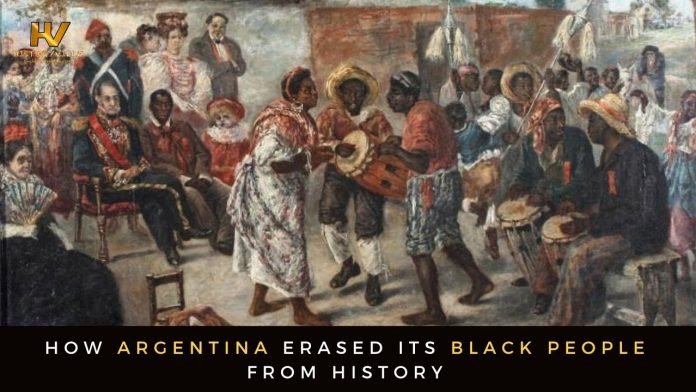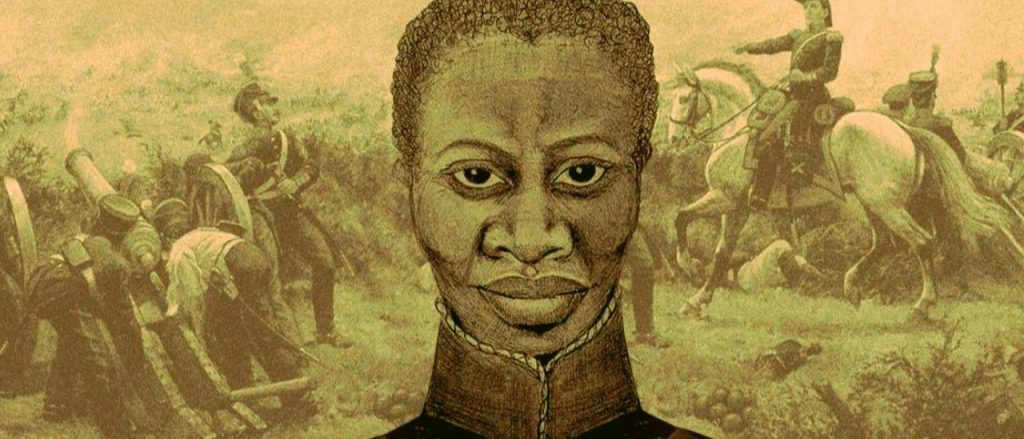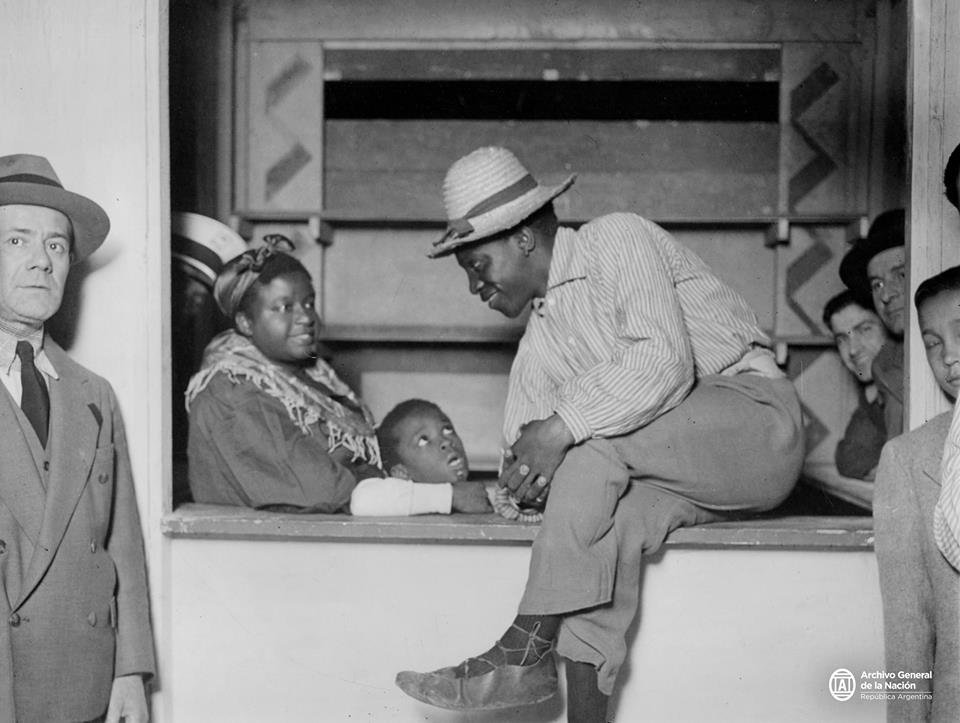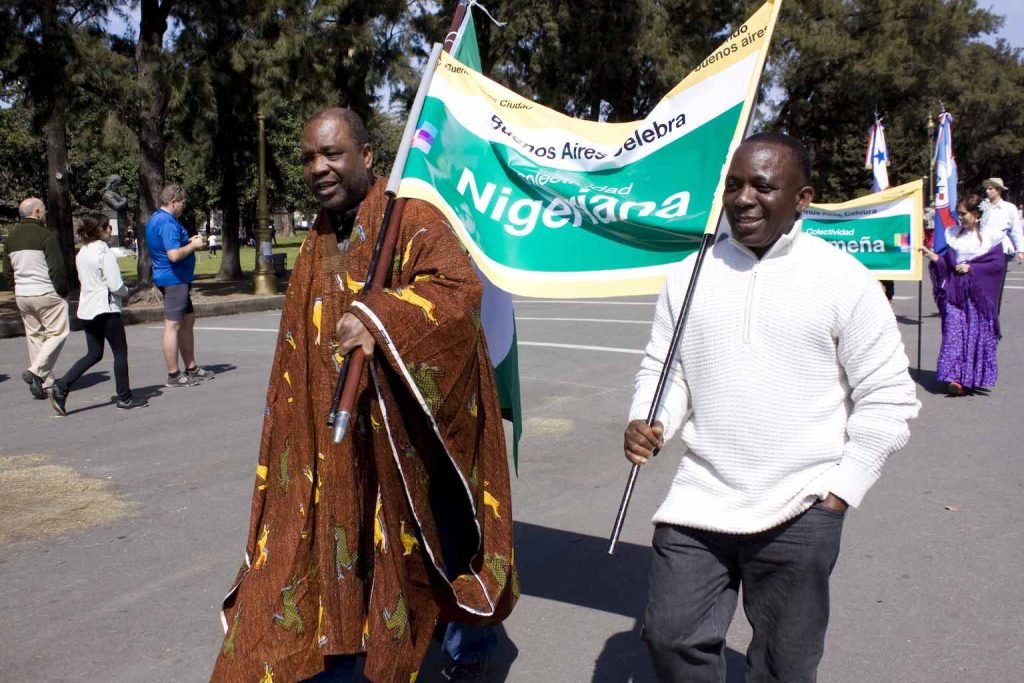Afro-Argentines: How Argentina Erased Its Black People from History
Only 5% of Argentina is Black – the lowest of all Latin American countries...
By
HistoryVille
-
June 22, 2022
6667
0
Share
https://www.facebook.com/sharer.php?u=https://www.thehistoryville.com/afro-argentines/
https://twitter.com/intent/tweet?te...ryville.com/afro-argentines/&via=HistoryVille
https://www.linkedin.com/shareArtic...rgentina+Erased+Its+Black+People+from+History
https://pinterest.com/pin/create/bu...rgentina+Erased+Its+Black+People+from+History
https://reddit.com/submit?url=https...rgentina+Erased+Its+Black+People+from+History
https://telegram.me/share/url?url=h...rgentina+Erased+Its+Black+People+from+History
https://api.whatsapp.com/send?text=...ps://www.thehistoryville.com/afro-argentines/

Afro-Argentines, as the Black people in Argentina are popularly known, formed a significant part of the Argentine population in the 18th century.
In 1778, according to a census by its Spanish colonial masters, Afro-Argentines made up 37% of the total population of the South American country. By 1857, 79 years later, the Black population had dropped to 15%.
Today, a greater population of Argentina is White. Only 5% of Argentina is Black – the lowest of all Latin American countries.
As a matter of fact, their numbers have reduced drastically that it would be near impossible to see Afro-Argentines in sports, journalism, politics, and so on.
So, what led to the reduction and near eradication of Afro-Argentines in Argentina? This is what this article seeks to find.
- A History of Afro-Argentines
- The Disappearance of the Afro-Argentines
- Afro-Argentines and the Argentine Wars
- Afro-Argentines and Gender Disproportion
- The European Immigration Policies
- Argentina’s Whitening Tactics of the 19th Century
- Afro-Argentines Today
- Sources
The history of Afro-Argentines dates back to the 16th century when Black people – feet chained – were brought from their homelands in Africa to be traded as slaves in Argentina. At the time, Buenos Aires, the capital city of Argentina had just been founded, and trading was the main commercial activity.

As the years went by, the numbers of slaves being traded in and out of Bueno Aires increased drastically. As of the 1600s, the slave trade industry had grown so much that about 70% of all trading in Buenos Aires involved importing slaves from Africa. It was only a matter of time before slave trading became a legalised trade in Argentina, extending far into the 1800s.
Although the slave trade in Argentina ended in 1813, slavery itself lasted until 1853 before it was finally abolished. When one looks at Buenos Aires now, in its clothing of architectural and structural beauty, it is hard to imagine that it once was an ugly site during the long years of the Black slave trade and trafficking which increased the Black population in the colony.
Data recorded in the 1778 census carried out in Argentina by the then Spanish colonial masters showed that about 30% of the people in Buenos Aires were Black. By the time the slave trade was ended in the 19th century, Afro-Argentines accounted for one-third of Argentina’s population – even though many of them were descended from slaves and some were still in slavery.
Not only were the Blacks a robust community, but the Afro-Argentines were also involved in and actively influenced the Argentine culture with their African ways. For instance, the popular Tango musical style and dance which was developed in Argentina has its roots traced to the African country of Angola.
The Disappearance of the Afro-Argentines
The belief that Black ancestry or descent does not exist in Argentina is one that is expected from a country that claims so much Whiteness. This belief sets a logical problem against the claims that the erasure of black history occurred in Argentina. After all, if black people never existed in the country, how could they have disappeared?
As it appears, some are still ignorant of facts concerning the history of Afro-Argentines. Nevertheless, this ignorance does not invalidate the fact that a Black community existed in Argentina but was erased around the early 20th century.
Perhaps, a better question would be, “Was the Black account erased from Argentine history?” Or “Did Argentina erase its Black people from history?
One thing is certain: Black people did not just vanish from the historical accounts of Argentina – the Afro-Argentines were written out of it.
The real question to be asked then is, how? How was a whole racial population washed out of history?

The history-loving mind is so curious that it seeks answers to this question. It is no surprise then that many have tried to give different answers regarding the disappearance of the Black populace in Argentina, some less satisfactory than others.
Truly, the disappearance of the Black population occurred in different ways, few were circumstantial but some were intentional. These ways are different yet when combined, give a well-rounded explanation of how Argentina erased its black people from history. These combined methods were demonstrated acts under the umbrella of Whitening.
Whitening can simply be described as an act of reimagining a race towards Whiteness. The rationale behind this act is that there exist some societal privileges that benefit white people compared to people of other races. This ideology holds that the above is true even if both races are exposed to the same social, economic and political conditions.
By implication, it means that Black people are of a race, inferior to the Whites. Also, by extension, the ideology is backed by the belief that Black people should be erased by the gradual loss of their Black genes through marriages to Whites and birthing children who, based on their whiter skin, will be closer to the White construct and standard.
Initially, the usage of the word “Whitening” in Argentina was little about colour and more about overall attitude and cultural behaviour. It made no difference, however, because both interpretations implied, led to the discriminative behaviour exhibited by White Argentines towards people who were not White.
Brushing aside the underlying issues of inequality and racial discrimination, the Argentinian government subtly believed and acted out this ideology. However subtly they may have acted, it is evident today that Argentina has been whitewashed.
Afro-Argentines and the Argentine Wars
For almost a decade, the Argentine War of Independence, which started in 1810, was fought, and in 1816, Argentina gained its independence from Spain.
It is well within the realm of possibilities that Black men who were at the time still slaves would have been forced into the battle fronts and became the greater casualty. Notable amongst these slave soldiers was Maria Remedios del Valle, who fought in the Argentine independence war along with her husband and sons.
Originally, one of the popular answers as to how Afro-Argentines were erased from Argentine history is the idea that these 18th-century wars claimed the lives of many Black men who represented the larger part of the Black population.

Admittedly, Black lives were lost in the many wars that happened in Argentina. However, to claim these events solely account for the disappearance of Afro-Argentines in Argentina is simply an exaggeration, because, after the abolishment of slavery in 1853, the Black population still made up about one-third of the population. It is unlikely, therefore, that the wars were responsible for the drastic fall in the black population after the 1800s.
Such exaggerated details should be expected when historical accounts have been altered, and consequently, are not trustworthy. Indeed, this exaggerated version is what some believe to be true as to how the Black population faded out of Argentina.
Very little is known about the state of the Afro-Argentines in Buenos Aires and Argentina after the wars. So poorly considered were the Blacks that it appeared the government thought them too insignificant to be included in the national census.
Was the Black population that low? Or were Afro-Argentines just neglected? Perhaps, this was the initiating act of what later became racial profiling. At any rate, if the Afro-Argentines really died out due to the wars, though this claim is unsupported by statistics, it is even greater evidence of Argentina’s cruel intent and effort to whiten its history. After all, murder is in one’s heart before it is in the hand.
Afro-Argentines and Gender Disproportion
Resulting from the loss of Black lives in the wars, the number of Black men who represented the larger part of the Black population was greatly reduced. Accordingly, women became the larger part, and as a result, what was once a fairly balanced ratio of men to women had become disproportionate.
This, amongst other things, facilitated the rise of interracial marriages in Argentina. Since the number of Black men was on the decrease, Black women were left with two choices – get married to Argentine men or contest for the few African men who were left. Some chose, if it could be considered a choice, the latter. What is strange, are the conclusions that were drawn from this choice.

Some have concluded that Blacks wanted a place where they belonged. So, after the abolishment of slavery, many Afro-Argentines migrated from Argentina to nearby countries with more predominant acceptance of Black people such as Brazil. Apparently, this conclusion was arrived at, because some families were, in fact, purely Black.
However, this theory is unsatisfactory and insufficient on its own to explain how the Black population completely fizzled out of the history of Argentina. Even if true, is migrating out of a country tantamount to migrating out of the country’s history? Well, this scheme apparently believes so.
The European Immigration Policies
Arguably, one of the most subtle acts taken by the Argentine government to wash its history of Blackness was the call for European immigrants. This is a fact attested to by statistics which link two-thirds of the population of Argentina to European immigration.
In the 19th century following the series of wars, Argentina made the call for immigrants from Europe, probably due to the low population of the country that had resulted from the loss of lives in the wars.
In 1853, the Constitution currently in use by Argentina was approved. Though it had seen the abolishment of slavery, the 25th Article of the Constitution was that which officially facilitated immigration into Argentina without any form of barrier. This limitless access into the country is rightly perceived to be suspicious.

Whether at that point, Argentina had intended that the European immigration be used as a means to white-wash its history, as it was already nearing that point, it eventually did.
With more European immigrants in Argentina, the prospects for a whiter country were raised. At last, there were more White people to dilute the growing Black population and gradually, a new mixed race was created. However, racial profiling would be unavoidable in a country that prides itself deeply on its European heritage, and such was the case in Argentina.
Argentina’s Whitening Tactics of the 19th Century
The new generation of people born through interracial marriages was referred to as the non-Whites, a superficial term that embodied the government’s denial of racial diversity which was present in Argentina. If placed on a ranking system, non-Whites would be a little higher than pure Blacks, and Whites higher than both. In this way, Argentina set the stage for the commencement of its Whitening, with interracial marriages particularly functioning as the whitening cream.
Luis Monti remains the only player in history to have played in two FIFA World Cup final matches with two different national teams, Argentina and Italy. He received death threats in both matches. pic.twitter.com/AeuOuqTuiO
— H i s t o r y V i l l e (@HistoryVille) December 3, 2022
One can understand why some Afro-Argentines sought interracial marriages to climb up the social ladder. What other alternative existed in the face of discrimination? Amongst other lack of rights, Black people could not attend universities before the abolition of slavery in 1853, White children had a longer number of schooling years than Black children, and Black people had no access to healthcare due to their poor economic and financial state.
The rate of infant mortality was higher for Black children when compared to Whites. The Afro-Argentines lost a higher percentage of their population to cholera and the yellow fever epidemic which broke out in the years 1864 and 1871 respectively. These health challenges were partly responsible for the disappearance of the Black community in Argentina.
In like fashion, children with mixed parents of Whites and non-Whites were seen to have become somewhat whiter as evident in their lighter skin tone and could enjoy rights exclusive to the Whites. Thus, their social status and that of their descents were raised, with a lesser chance of being discriminated against.

At this point, Black women had two options; become Whiter and access more rights, or continue to be Black and suffer discrimination. That was not the first or the last time they would face this alternative, and their choice was always the same. The bait had been designed so cleverly by the Argentine government that anyone would bite.
Accompanied with the Whitening was a loss in Black identity, not just in genetic makeup and skin colour but in consciousness also. That 90% of the people in Argentina today identify to be White, is proof that many Argentines are ignorant of their ancestry so much so that they can’t tell if they are indeed White or are descended from Afro-Argentines.
Afro-Argentines Today
The masked racial discrimination that has fed Argentina’s erasure of its Black history is astounding and it has caused multiple reverberations for generations. While the lives of Afro-Argentines were lost, the Black consciousness and Black accounts were also lost to history. In recent times, sequel to the re-emergence of the Black community in the 20th century, Afro-Argentines continue to fight to bring back and keep the Black account in Argentine history by telling their stories.
A memorable feat was achieved when November 8 was assigned by the Argentine legislation to celebrate Maria Remedios del Valle, the Afro-Argentine soldier who fought for Argentina during the Argentine War of Independence in the 1810s. Since 2013, November 8, officially referred to as the national day of Afro-Argentines and African Culture, has served as a day when Argentina revisits and celebrates its African roots.
Still, the question of whether Argentina is truly a White country or not persists. This question does not fit into a “black or white” structure, but one thing is certain – White Argentina will find it very hard to completely get rid of the Black footprints in its archives, which is a good thing; especially for the Afro-Argentines who have been denied a substantial part of their ancestral history.
We always have more stories to tell. So, make sure you are subscribed to our YouTube Channel and have pressed the bell button to receive notifications for interesting historical videos. Also, don’t hesitate to follow us on all our social media handles and to as well share this article with your friends.
Feel free to join our YouTube membership to enjoy awesome perks. More details here…
Sources
BBC. (n.d.). What it’s like to be black and Argentine. BBC News. Retrieved May 11, 2022, from
Edwards, E. D. (2021, June 24). Perspective | the history behind the removal of Argentina’s version of ‘aunt jemima’. The Washington Post. Retrieved May 11, 2022, from https://www.washingtonpost.com/outl...ehind-removal-argentinas-version-aunt-jemima/
Gate Jr., H. L. (2014, July 13). True or false: There are no black people in Argentina. The Root. Retrieved May 11, 2022, from https://www.theroot.com/true-or-false-there-are-no-black-people-in-argentina-1790876367/
Goñi, U. (2021, February 8). The hidden history of black Argentina: Uki Gobi. The New York Review of Books. Retrieved May 11, 2022, from https://www.nybooks.com/daily/2021/02/08/the-hidden-history-of-black-argentina/
Goñi, U. (2021, May 31). Time to challenge Argentina’s white European self-image, black history experts say. The Guardian. Retrieved May 11, 2022, from https://www.theguardian.com/world/2021/may/31/argentina-white-european-racism-history
Guzmán, F., & Edwards, E. D. (2020, September 24). María Remedios del Valle, Nineteenth-century Argentina (chapter 20) – as if she were free. Cambridge Core. Retrieved May 11, 2022, from https://www.cambridge.org/core/book...ry-argentina/A3EF608DBBC4E013BB8D88AC8B6EE620
Reel, M. (2005, May 5). Argentine researchers exhume African roots. NBC News. Retrieved from https://www.nbcnews.com/news/amp/wbna7739809
Sánchez-Alonzo, B. (2013, May 2). Making sense of immigration policy: Argentina, 1870-1930 – JSTOR. Retrieved May 11, 2022, from https://www.jstor.org/stable/42921570
Sciaudone, C. (2021, November 26). Argentine movement tries to make Black heritage more visible. AP News. Retrieved from https://apnews.com/article/immigrat...nd-ethnicity-0d18920b22e0eab19f28202c591ef0ea
U.S. Department of State. (n.d.). A Guide to the United States’ History of Recognition, Diplomatic, and Consular Relations, by Country, since 1776: Argentina. U.S. Department of State. Retrieved May 11, 2022, from https://history.state.gov/countries/argentina

Discover the Untold History of Nigeria – HistoryVille
Learn more about the fascinating history of Nigeria with captivating articles and interactive content that show the country’s vibrant history, culture, and people.
 www.thehistoryville.com
www.thehistoryville.com

